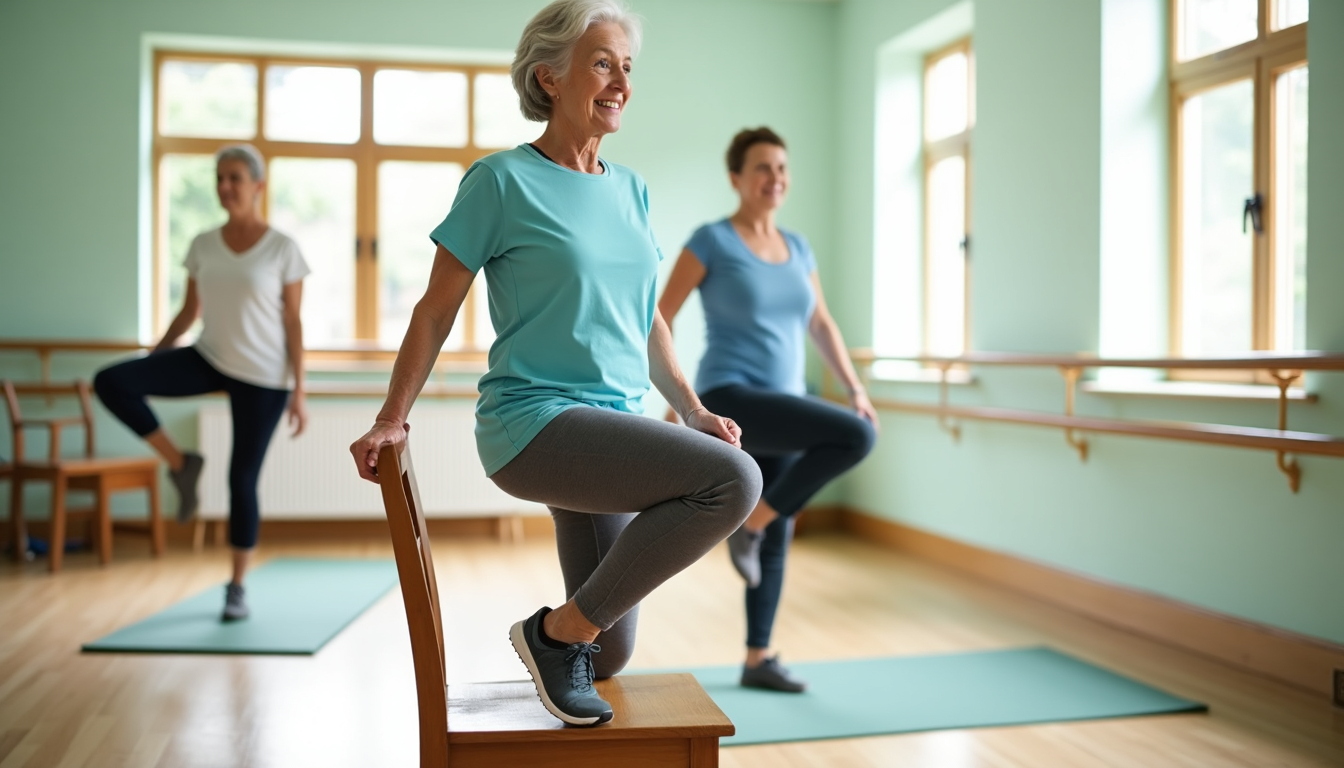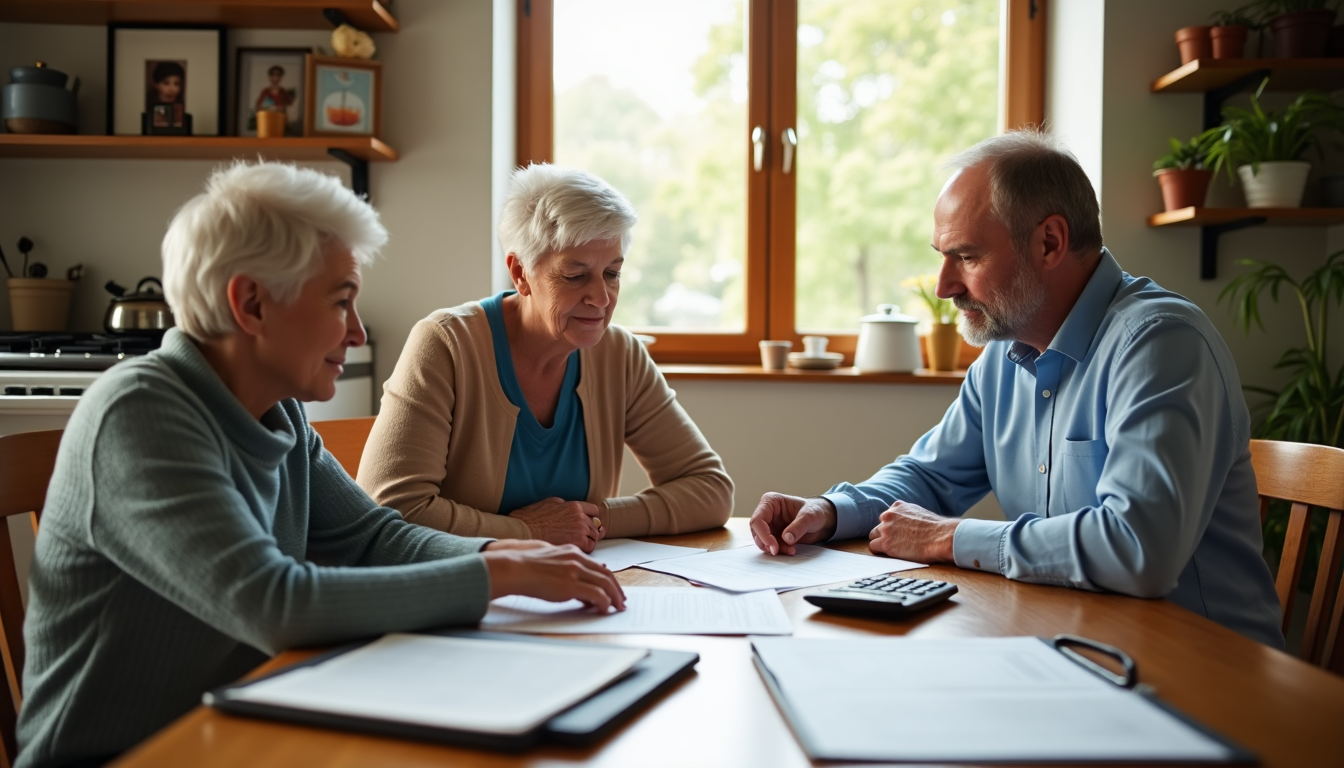An older adult experiences a fall every second in the United States, according to recent data. Even more concerning, over 25% of adults aged 65 and older fall each year, with 3 million requiring emergency treatment for fall-related injuries.
Balance exercises can significantly improve seniors’ quality of life by enhancing their ability to move independently and safely. These exercises help older adults stay steady on their feet and maintain independence through regular practice.
The CDC reports that many falls are preventable with the right approach and consistent exercise. Balance training provides practical tools for both improving personal stability and helping others enhance their balance through safe, effective exercises that can be performed at home.
This guide covers everything from basic seated movements to advanced standing exercises. Each section provides specific techniques to build better balance and prevent falls. The information begins with understanding why balance matters for seniors and how to assess current stability levels before starting any exercise program.
Understanding Balance and Why It Matters for Seniors
Balance naturally declines as part of the aging process, beginning as early as our 30s. The vestibular system—a critical sensory network in our inner ear that helps maintain stability—starts deteriorating around age 40, with those tiny hair cells responsible for balance sensing gradually wearing down. This biological change, combined with muscle loss, creates conditions for instability in later years.
Aging bodies experience multiple changes affecting balance:
- Muscle mass decreases by up to 50% by our 70s
- Sensory systems (vision, vestibular, somatosensory) become less efficient
- Joint mobility and coordination diminish
- Cognitive processing slows, affecting real-time balance adjustments
This age-related decline makes falls a significant health concern. Approximately 30% of adults 65 and older experience balance problems or dizziness at some point. Falls remain the leading cause of injury among people over 65, costing society approximately $50 billion annually for non-fatal falls and $754 million for fatal falls.
Maintaining good balance directly reduces fall risk. Many balance disorders can be treated or managed effectively through specific exercises and rehabilitation techniques.
Several warning signs indicate balance needs attention:
- Feeling unsteady when standing or walking
- Experiencing dizziness, vertigo, or a floating sensation
- Requiring support to rise from sitting
- Difficulty walking in the dark or on uneven surfaces
- Taking shorter, wider steps than before
Balance difficulties aren’t simply inevitable age-related changes—they’re often symptoms of treatable conditions. Poor balance frequently stems from medication side effects, inner ear problems, vision changes, or health conditions like diabetes or arthritis.
Understanding these physical changes represents the first step toward maintaining independence and preventing falls through targeted balance exercises.
Getting Started with Simple Balance Exercises at Home
Starting a balance exercise routine requires proper preparation to ensure both safety and effectiveness. Balance training forms one of four essential exercise categories alongside strength, flexibility, and endurance—with studies showing it can lower injury risk by over 40% through improved joint stability.
Essential safety precautions before you begin
Consult your healthcare provider before starting any balance exercise program. This step ensures the exercises are safe and appropriate for your specific health conditions.
When practicing balance exercises:
- Choose a flat, non-slippery surface in a well-lit, clutter-free area
- Position yourself near a sturdy object (wall, chair, or table) for support
- Wear supportive, non-slip footwear
- Start with simple exercises, gradually increasing difficulty
- Begin with a 5-7 minute warm-up to prepare muscles and joints
Safety must always be your priority—if you feel unsteady or fatigued, consider seated or lying positions initially.
Equipment you’ll need (and what you don’t)
Effective balance training requires minimal equipment. Basic supplies include:
- A sturdy chair for support
- Comfortable, non-restrictive clothing
- Supportive shoes (or barefoot for some exercises)
- Water to stay hydrated
Although specialized equipment exists (balance balls, foam mats, cushions), these aren’t essential for beginners. As you progress, you might add simple items like soft foam balls or balance disks to increase challenge levels.
The 5-minute balance assessment
Before starting your routine, assess your current balance capabilities with this simple test:
- Stand barefoot next to a wall or countertop
- Lift one foot approximately one inch off the floor
- Time how long you can maintain this position before needing support
- Repeat three times with each leg, recording your best time
- Try again with your eyes closed (only if safe to do so)
If you cannot hold the position for at least 10 seconds, this indicates an increased fall risk. This assessment helps determine your starting point and track improvements as you progress.
These preparatory steps establish a safe foundation for your balance improvement journey.
Beginner Balance Exercises for Limited Mobility
Many seniors face mobility challenges that make traditional standing exercises difficult. Effective balance training can begin from virtually any position, including seated exercises that build core strength without strain.
Seated balance exercises
Seated exercises provide a safe starting point for those with limited mobility. Begin by sitting on the edge of a sturdy chair without back support, keeping both feet flat on the floor. Try these movements:
- Seated Forward Reach: Hold a small ball or light weight, extend your arms, and reach forward until you feel slightly unsteady, then return to the starting position. Repeat 10 times.
- Trunk Rotations: Clasp your hands at shoulder height and turn to one side as far as possible without losing balance. Return to center and repeat on the opposite side, performing 10 repetitions for each direction.
These seated activities increase blood flow, keep joints lubricated, and build upper body strength—all crucial for overall stability.
Standing exercises with support
As comfort grows, progress to standing exercises while maintaining support:
Chair-Assisted Sit-to-Stand: Place your hands on the chair seat or armrests. Lean your chest forward over your toes, squeeze your gluteal muscles, and slowly rise to standing. Gradually lower yourself back down. Aim for 10 repetitions, eventually working toward not using your hands.
Standing Marches: While holding onto a countertop or chair back, alternately lift each knee as high as comfortable. This strengthens core muscles that support your spine, improving overall stability.
Wall-assisted balance movements
Wall exercises offer reliable support while building strength:
Wall Pushups: Stand arm’s length from a wall, place your palms flat against it at shoulder height. Lean forward, bringing your body toward the wall, then gently push back until arms are straight. Perform 20 repetitions to build arm and core strength.
Modifying these exercises to match your abilities and consistently practicing them helps develop the foundation needed for more advanced balance activities.
Intermediate and Advanced Balance Exercises
Growing confidence with basic balance exercises opens the door to more challenging movements. These intermediate and advanced exercises enhance stability and reduce fall risk by engaging multiple systems simultaneously.
Dynamic walking patterns for better stability
Dynamic walking exercises mimic real-life scenarios, helping maintain balance during everyday movements. Try these variations:
- Walking backward: Focus on reaching your leg backward in a toe-to-heel pattern, using a wall or countertop for support if needed. This improves coordination by relying on your proprioceptive system rather than visual cues.
- Walking with head turns: Walk forward while turning your head to the right for a few steps, return to center, then repeat on the left. This enhances vestibular system integration, essential for maintaining stability when your visual field shifts.
- Heel-to-toe walking: Walk forward placing each heel directly in front of the opposite toe, as if on a tightrope. This challenges balance control and strengthens stabilizing muscles.
Single-leg exercises to build strength
Single-leg exercises develop the strength and stability needed to navigate daily activities safely:
- Standard single-leg stance: Stand on one leg near a support, holding for 10-30 seconds before switching sides. Repeat 5 times per leg.
- Single-leg balance with movement: While balancing on one leg, slowly move the other leg forward, to the side, and backward in a controlled manner.
To increase difficulty, try closing your eyes during these exercises or stand on a softer surface like a cushion.
Challenge exercises for those ready for more
For those seeking additional challenge:
- Dual-task exercises: Perform balance exercises while simultaneously completing cognitive tasks, such as counting backward or naming animals.
- Square-stepping exercise: Follow specific stepping patterns (forward, backward, lateral, diagonal) on a mat divided into squares. Studies show this produces greater improvements in leg power and reaction time compared to regular walking.
- Tai Chi: This ancient practice combines slow, rhythmic movements with weight shifting and trunk rotation, proving more effective for balance improvement than many other exercises.
Practice these advanced exercises 2-3 days per week, progressively increasing difficulty as abilities improve.
Creating Your Personal Balance Exercise Routine
Consistent balance practice yields impressive results over time. Research shows older adults who followed a regular balance program for just six weeks experienced significant improvements in both balance and confidence.
How to track your progress
Monitoring balance improvements helps maintain motivation. Try these simple tests monthly:
- Timed Up and Go (TUG) Test: Measure how long it takes to stand from a chair, walk 3 meters, turn, return, and sit
- Single Leg Stance Test: Record how many seconds you can stand on one foot
- Functional Reach Test: Measure the maximum distance you can reach forward while standing
Consider keeping a balance journal noting improvements in daily activities like getting up from chairs or walking on uneven surfaces. Those with serious concerns should seek a comprehensive assessment from a physical therapist.
When and how to increase difficulty
As exercises become easier, gradually increase challenge instead of jumping to harder routines. Start with basic level exercises incorporating one or two components, then advance to moderate (three to four components) and advanced levels (more than four components, including dual tasks).
To progress effectively:
- Add gentle movements while holding balance positions
- Reduce your support surface (standing on a cushion)
- Close your eyes during static exercises
- Incorporate cognitive tasks while balancing (counting backward)
- Use unstable surfaces like balance disks or foam mats
Sample weekly balance exercise plans
Optimal balance training requires 10-15 minutes of practice three days weekly. Each session should include a 5-7 minute warm-up, followed by seated exercises (15 minutes) and standing/walking exercises (15-20 minutes).
Beginners should focus on seated balance exercises before gradually incorporating standing exercises with support. As stability improves, add dynamic walking patterns and single-leg exercises to your routine. Balance exercises should precede resistance and flexibility activities in your workout sequence.
Conclusion
Balance exercises serve as essential tools for maintaining independence and safety during senior years. Studies show dedicated practice leads to significant improvements in stability, substantially reducing fall risks for older adults.
Success comes from starting at a comfortable level and advancing gradually. Whether beginning with seated exercises or progressing to advanced movements, consistency remains the key factor in building better balance.
Starting a balance journey requires prioritizing safety, tracking progress regularly, and acknowledging improvements along the way. Consulting healthcare providers ensures exercise routines align with specific needs and capabilities of each individual.
Maintaining good balance enables seniors to live confidently and independently. Through proper assessment, consistent practice, and gradual progression, older adults can build the stability needed for an active, fulfilling lifestyle well into their senior years.
FAQs
Q1. What are some effective balance exercises for seniors? Some effective balance exercises for seniors include standing on one foot while holding onto a chair for support, heel-to-toe walking, chair squats, and practicing Tai Chi. It’s important to start with simple exercises and gradually increase difficulty as balance improves.
Q2. How often should seniors do balance exercises? Seniors should aim to practice balance exercises for 10-15 minutes, at least three days per week. Consistency is key for seeing improvements in stability and reducing fall risk.
Q3. Can balance be improved in older adults? Yes, balance can be improved in older adults through regular practice of targeted exercises. Even those with limited mobility can benefit from seated balance exercises before progressing to standing exercises with support.
Q4. What safety precautions should seniors take when doing balance exercises? Seniors should consult their healthcare provider before starting a balance exercise program, choose a flat, non-slippery surface, position themselves near a sturdy object for support, wear supportive footwear, and start with simple exercises before gradually increasing difficulty.
Q5. How can seniors track their progress in balance improvement? Seniors can track their progress by performing simple tests monthly, such as the Timed Up and Go (TUG) Test, Single Leg Stance Test, and Functional Reach Test. Keeping a balance journal to note improvements in daily activities can also be helpful.












